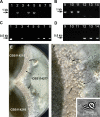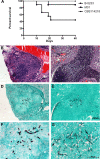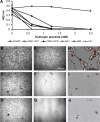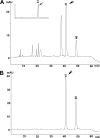Neosartorya udagawae (Aspergillus udagawae), an emerging agent of aspergillosis: how different is it from Aspergillus fumigatus?
- PMID: 19889894
- PMCID: PMC2812273
- DOI: 10.1128/JCM.01556-09
Neosartorya udagawae (Aspergillus udagawae), an emerging agent of aspergillosis: how different is it from Aspergillus fumigatus?
Abstract
A recent report on several cases of invasive aspergillosis caused by Neosartorya udagawae suggested distinctive patterns of disease progression between N. udagawae and Aspergillus fumigatus. This prompted us to characterize N. udagawae in comparison to A. fumigatus. Our findings showed that both species exist in two mating types at similar ratios and produce gliotoxin. However, the thermotolerance of the two species differs: while A. fumigatus is able to grow at 55 degrees C but not at 10 degrees C, N. udagawae is able to grow at 10 degrees C but fails to grow at >42 degrees C. Furthermore, compared to A. fumigatus, the conidia of N. udagawae require longer incubation periods to germinate at 37 degrees C and are more susceptible to neutrophil attack as well as hydrogen peroxide; N. udagawae is also less virulent in gp91(phox-/-) mice. These findings suggest that growth and susceptibility to the host response might account for the reduced virulence of N. udagawae and the subtle distinction in the progression of the disease caused by the two species.
Figures








References
-
- Belkacemi, L., R. C. Barton, V. Hopwood, and E. G. Evans. 1999. Determination of optimum growth conditions for gliotoxin production by Aspergillus fumigatus and development of a novel method for gliotoxin detection. Med. Mycol. 37:227-233. - PubMed
Publication types
MeSH terms
Substances
Grants and funding
LinkOut - more resources
Full Text Sources
Medical

